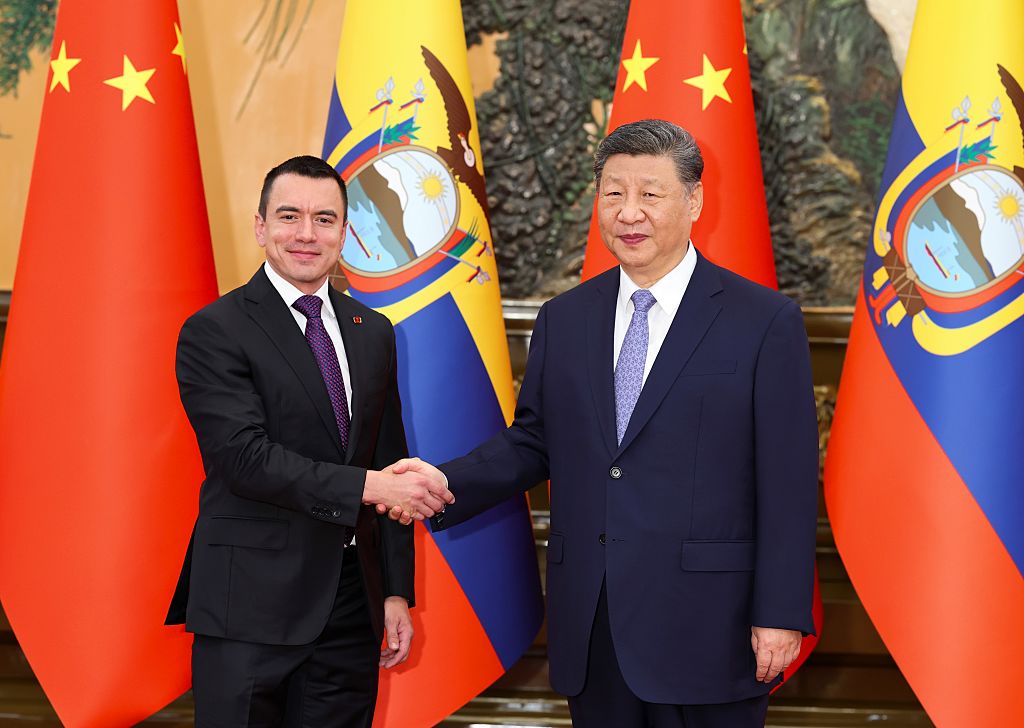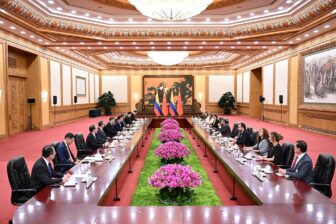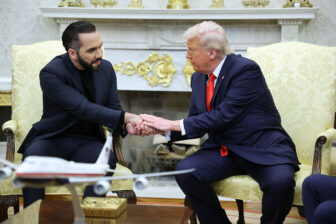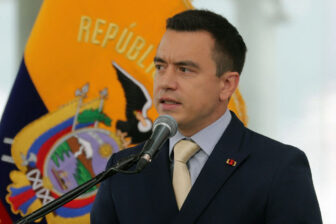QUITO—As global tensions sharpen and economic lifelines become scarce, Ecuador is turning once again to a significant—and controversial—partner: China. Last week, and marking the first international trip of his new term, President Daniel Noboa visited the Asian country seeking fresh capital, infrastructure deals, and strategic partnerships to anchor a fragile economy that is teetering under energy and fiscal constraints.
It wasn’t just a routine diplomatic mission. Noboa met with top Chinese officials, including Premier Li Qiang and President Xi Jinping, and signaled a shift from ideological posturing to pragmatic statecraft. In turn, Xi endorsed a deeper Belt and Road Initiative with Quito, affirming the strategic value both sides place on the relationship.
On paper, the visit has rendered only one specific announcement so far. Power Construction Corporation of China agreed to invest $400 million in renewable energy and storage. But more decisions may be coming soon. Government officials mentioned the possible transfer of major hydroelectric plants and oil fields to Chinese companies as part of a broader investment package between the two countries.
While Ecuador maintains a close relationship with President Donald Trump and his administration, this visit and deals signal a deeper engagement with China. Speaking at the World Economic Forum’s “Summer Davos” in Tianjin, Noboa announced that “the era of ideology is over,” underlining Ecuador’s desire for practical partnerships over political alignment.
As global geopolitical tensions and ambitions run high, will Noboa be able to successfully court Beijing and Washington simultaneously in the current environment?
Benefits under review
Over the past twenty years, Ecuador’s relationship with China has expanded rapidly. Ecuadorian exports to China grew a hundredfold, reaching $5 billion last year, while imports increased nearly tenfold to $6.6 billion. This makes China Ecuador’s second-largest trading partner overall and its leading partner for non-oil products.
Beyond trade, China became a key financier for the Ecuadorian government and major public infrastructure and energy projects between 2009 and 2019, providing over $11 billion in policy bank loans. As a result, despite having a relatively small economy, Ecuador has been the third-largest recipient of Chinese financing in Latin America and the Caribbean.
China has also been a major source of capital investment, accounting for 50% of all FDI registered last year, with Chinese companies heavily involved in key sectors such as oil, mining, and the automotive industries. Chinese firms currently own Ecuador’s largest private oil and mining operations, and Chinese automakers have significantly increased their market share in Ecuador’s new-car sales, capturing 37% of all sales in the first half of 2025.
In May 2023, Ecuador became the third South American country, after Peru and Chile, to sign a free trade agreement (FTA) with China— while remaining the only country on the Pacific coast of the Americas without an FTA with the U.S.
Despite these positive developments, however, China’s engagement with Ecuador has faced challenges. The massive Coca Codo Sinclair dam, a major hydroelectric project financed and built by Sinohydro, has been plagued by structural defects, limiting its full operational capacity and leading to legal disputes. Concerns persist regarding Chinese firms’ predatory business tactics, lack of transparency, quality issues, and contract structuring designed to favor Chinese interests.
Additionally, the controversial Chinese-built ECU-911 surveillance system has raised privacy concerns, and the Ecuadorian government is reportedly now seeking Western firms for repairs and upgrades. Additionally, China’s previous assertive diplomatic maneuvers, such as the temporary suspension of shrimp exports or the presence of its deepwater fishing fleet near the Galápagos, have been interpreted as pressure tactics during debt and other negotiations.
Nonetheless, these developments have deeply integrated Ecuador’s economy with China’s, explaining why successive Ecuadorian governments, regardless of their political alignment, have sought to maintain strong relations with Beijing.
Noboa’s visit is also driven by Ecuador’s urgent need for economic lifelines. His administration aims not only to refinance Ecuador’s current debt with China — which has significantly decreased to less than 7% of all foreign debt — but also to expand it again. This strategy seeks to limit dependence on IMF and multilateral financing and enhance repayment capacity to reduce the country’s risk premium, with the goal of returning to capital markets next year.
The nation is also struggling with a stagnant economy over the past decade and an unreliable energy infrastructure that led to widespread power cuts last year. Major Chinese investments in energy, infrastructure, and extractive industries could be one of the few sources of economic growth in the short to medium term.
However, Noboa’s trip to Beijing unfolds within a complex international landscape marked by heightened tensions between China and the U.S., including veiled demands from the latter for countries to “choose sides.” Yet, with China being the top trading partner for nearly every South American country, decoupling from Beijing is simply not a viable option, especially for Ecuador. In this scenario, as my colleagues and I argued in this 2022 report, Ecuador should engage pragmatically with both global powers, maximizing opportunities by leveraging each partner’s comparative advantages.
Partners in the new century
Specifically, the U.S. remains Ecuador’s most suitable partner for security cooperation, including counter-narcotics efforts, monitoring illegal fishing, sharing intelligence, and strengthening democratic institutions and good governance. The U.S. also offers diplomatic support on human rights and rule of law.
Conversely, China’s comparative advantage lies heavily in investment, lending, and large-scale public works projects, often characterized by speed, competitive cost, and a willingness to provide financing with fewer conditions on policy compared to Western institutions. China also offers a massive, untapped market for Ecuadorian exports.
This balanced approach, while mitigating past errors by introducing greater transparency and citizen oversight on Chinese contracts, would be the optimal path to avoid the unviable option of choosing one side entirely.
Crucially, President Noboa has existing pro-U.S. credentials and connections that provide a unique opportunity to pursue this pragmatic strategy without unduly alienating Washington. In fact, Noboa is an American citizen himself, and has cultivated ties with the Trump orbit, even briefly meeting at Mar-a-Lago earlier this year. Plus, his government has actively sought increased support from the Trump administration to combat transnational crime.
This established rapport with Washington could potentially alleviate suspicions from the Trump administration regarding Ecuador’s deepening engagement with China. A potentially less punitive “wait-and-see” approach from Washington towards countries like Ecuador that also maintain strong U.S. ties might allow Noboa greater flexibility. However, Noboa should be careful to consider excluding security-sensitive infrastructure — like ports or telecommunications technology — from potential agreements with China.
Noboa’s visit to Beijing reflects Ecuador’s strategic imperative to pursue economic development and stability in a world reshaped by great power competition. With U.S. aid shrinking just as China steps up funding for scholarships and other local projects, and new U.S. tariffs nudging Ecuador toward alternative markets, a pragmatic foreign policy represents a delicate balancing act.
For Ecuador, its future development will depend on skillfully navigating this geopolitical tightrope, leveraging the strengths of both giants to serve its own urgent national interests.









